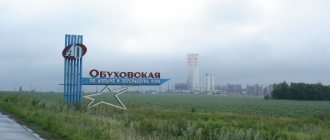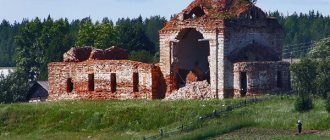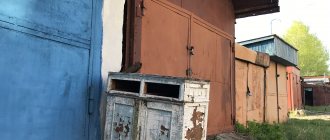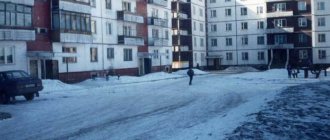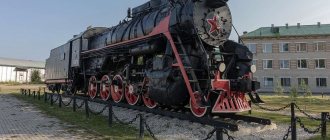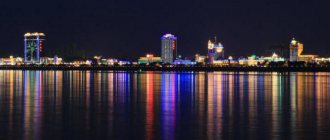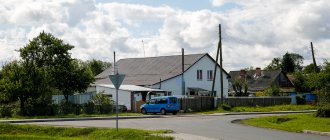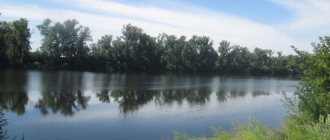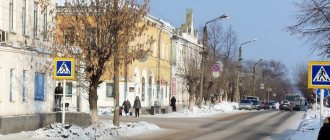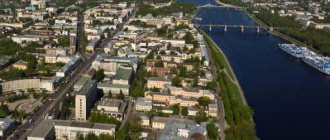Photo: amurarhiv.ru
The name of the capital of the Amur region was given by the Church of the Annunciation (“good news” - the news of the birth of Jesus Christ), around which the city was built at the confluence of the Amur and Zeya. Initially, in this place, in 1856, the Ust-Zeya military post was founded. The church was founded two years later. On July 5, 1858, an imperial decree was issued on the establishment of the city of Blagoveshchensk: “Sovereign Emperor, according to the most submissive report of His Imperial Majesty the Grand Duke, Admiral General, the considerations of the Governor General of Eastern Siberia on the special importance of the location of the Ust-Zeyskaya village, located at the confluence of the Zeya River Amur and named by the Governor-General, on the occasion of the foundation of a church in the name of the Annunciation of the Blessed Virgin Mary on May 9, “Blagoveshchenskaya Stanitsa,” on the 5th day of July of this year deigned to give the highest command: to establish a city in this place, calling it “Blagoveshchensk.” .
The first settlement on the site of the present Shimanovsk was founded in 1910 during the construction of the Trans-Siberian Railway. The village was given the name Pera because of the Bolshaya Pera River flowing in the upper reaches. In 1912, it and the railway station were renamed in honor of the ethnographer, who later became the governor of the Amur region, Nikolai Gondatti. Six years later, other heroes took over. The station was combined with the settlement into a single settlement with the common name Vladimiro-Shimanovsky, in memory of the revolutionary, a railway engineer who was shot during the Civil War in Blagoveshchensk.
Shimanovsky was the first head of the railway workshops at the Gondatti station, an active participant in the struggle for Soviet power in the Amur region. Later, the name Shimanovsky was assigned to the village, and in 1950 it was transformed into the city of Shimanovsk.
The most common hypothesis for the origin of the name is a translation from the Evenki language: “deya” or “dzhee” - blade. Zeya was named after one of the largest Amur rivers, and then the northern city. In 1879, in the taiga, still untouched by man, on the right bank of the Zeya River, at the foot of the Tukuringra ridge, the residence of the Upper Amur Gold Mining Company was founded. It was called the Zeya warehouse: supplies and tools for the mines were delivered here. By March 12, 1906, the village expanded to the city of Zeyskaya Pristan. And on November 3, 1913, at the request of the city government, it was renamed the city of Zeya.
The name of the capital of BAM was given by the Tynda River, and it was given its name by the indigenous people. There are several interpretations of the translation from the Evenki language: “a place where reindeer are unharnessed”, “rotten pit”, “shore” and from the verb “tynden” - “I let go”. In the 50s of the 19th century, mining engineer Pavel Anosov found gold in the Dzhalinda and Yankan rivers, flowing near present-day Tynda. Intensive development of deposits began, a mass of settlers, prospectors, and gold miners poured in. In 1907, on the site of Tynda, the Tyndinsky resettlement area was formed, which by 1917 had grown to the status of a village.
The famous barrels in which builders and their families lived.
An interesting detail: according to the plan, in 1943 the village was supposed to become a city, and by 1951 - a regional center. The war ruined the plans. In April 1974, BAM was declared an All-Russian Komsomol construction site. After the highway began to approach the village, it was renamed and received city status. The founding day of Tynda is November 15, 1975.
In 1908, the year the Emperor of Russia approved the bill on the construction of the Amur Railway, the village of Zmeiny was formed along the Bolshoi Never River. The name was given by thousands of local women who terrified the first settlers. At first it was an ordinary winter hut, where convoys stopped to rest. A year later, construction of the station village of Never-1 began here. In 1911, the Minister of Railways Sergei Rukhlov made a detour to the railway under construction and gave 10,000 rubles from his personal funds for the temple. To celebrate, the village was renamed Rukhlovo.
On November 15, 1922, the Far Eastern Republic became part of the RSFSR. In 25, two districts were created on the territory of the Amur region: Amursky with a center in Blagoveshchensk and Zeysky with a center in Rukhlov. Two years later, the village was given the rank of a city. And on December 16, 1938, the city of Rukhlovo (which by that time was in the Chita region) was renamed the city of Skovorodino - in honor of the chairman of the village council, Afanasy Nikolaevich Skovorodin, who was killed by the Japanese.
In 1912, a mineral exploration expedition laid the first adit in the area between the rivers Klyuch, Muravka, Tyukan and Kivda. In 1931, the Kivdo-Raichikhinskoye coal deposit was discovered in these places. And the next year the village of Raichikha was founded, named after the left tributary of the Amur - the Raichikha River. The exact origin of the name of this reservoir is still not known. There are three versions. Two family ones - in honor of the lower military rank of Raev, who drowned in it, and in honor of the soldier Raikov, who was in a settlement in this area. The third is lyrical. This is what the old-timers say: “There were more than 500 households in Old Raichikha, a good church, and two mills. The Cossacks wrote letters to their homeland, in which they said that there is not life here, but paradise, and the Chikhinka river flows, in which there is a lot of fish ... "
On March 8, 1934, the village received the status of a workers' settlement with the name Raichikhinsky. On May 4, 1944, by decree of the country's authorities, the workers' village was transformed into the city of Raichikhinsk of regional subordination.
The settlement of Dukhovskoye can be considered the ancestor of Raichikhinsk - on June 25, Spiritual Day, in 1918 it was founded by several families. This is where the first coal subsequently came from. Then the village was renamed Zelvino, in honor of a good man and the head of the mine, David Zelvin, who tragically died in a gas pit. Now Zelvino is a satellite of Raichikhinsk, adjacent to the southern outskirts of the city.
The Amur Region celebrates 160 years since its formation. On this day in 1858, by decree of Alexander II, its borders with the regional center - the city of Blagoveshchensk were designated
1860 is considered the year of foundation of Belogorsk. It was then that settlers from the Perm and Vyatka provinces founded Aleksandrovskoye on the left bank of the Tom River. In 1893, the village of Bochkarevka appeared in the neighborhood, and later the Bochkarevka railway station. All of them merged together in 1926, forming the city of Aleksandrovsk. 1931: renamed Krasnopartizansk. 1935: Kuibyshevka-Vostochnaya. 1957: Belogorsk. It is believed that the name is associated with the white banks of the river - the color was given by quartz sands.
The first settlers set up camp on the banks of the winding river in 1910. Because of its curves and curls, both the reservoir and the settlement were given the name Zavitaya. The station village was also called later. On November 18, 1954, it received city status and the name Zavitinsk.
Svobodny received its modern name in the spring of 1917. This decision was made by the residents themselves at a rally in honor of liberation from the oppression of the tsarist autocracy and the long-awaited freedom. Before this, the city was called Alekseevsk - in honor of the heir to the Russian throne, Tsarevich Alexei Nikolaevich Romanov. The settlement was founded on the site of the village of Surazhevka in connection with the construction of the Amur Railway - at this point it intersected with the Zeya River. To achieve this, the authorities alienated the Surazhevsky plot of land, since the village peasants categorically refused to become part of the future city. On July 30, 1912, on the birthday of the heir to the throne, Tsarevich Alexei, the foundation stone of the city of Alekseevsk took place. By the way, Surazhevka itself, which gave birth to Svobodny, was founded by settlers from the Surazh district of the Chernigov province in 1901.
In 1961, Uglegorsk was founded in the Svobodnensky district. The name of the village was given so that a potential enemy would not guess about the missile division located here. Of course, coal was not mined here. In 1969, the village was renamed Svobodny-18. In 1994, it was given the name “closed administrative-territorial formation of the village of Uglegorsk.” The construction of the Vostochny cosmodrome contributed to the radical change in the name of the settlement. In September 2015, deputies of the regional Legislative Assembly adopted a law changing the status of the village of Uglegorsk and transforming it into a city without changing the established administrative boundaries. In December 2015, the new Amur city was named after the scientist Konstantin Tsiolkovsky.
Age category of materials: 18+
- Arina Alexandrova
- Amurskaya Pravda from December 20, 2018
Climate
- Average annual air temperature - 0.5 °C
- Relative air humidity - 68.1%
- Average wind speed - 3.2 m/s
| Jan | Feb | Mar | Apr | May | Jun | Jul | Aug | Sep | Oct | But I | Dec | Year |
| −22.2 °C | −17.6 °C | −10.1 °C | 2.3 °C | 10.7 °C | 17.6 °C | 20.3 °C | 18.4 °C | 11.9 °C | 2.3 °C | −10.1 °C | −19.3 °C | 0.5 °C |
Excerpt characterizing Raichikhinsk
The hussar did not answer. - Well, don't you hear? – After waiting quite a long time for an answer, Rostov asked again. “Who knows, your honor,” the hussar answered reluctantly. - Should there be an enemy in the area? - Rostov repeated again. “It may be him, or it may be so,” said the hussar, “it’s a night thing.” Well! shawls! - he shouted at his horse, moving under him. Rostov's horse was also in a hurry, kicking the frozen ground, listening to the sounds and looking closely at the lights. The screams of voices grew stronger and stronger and merged into a general roar that could only be produced by an army of several thousand. The fires spread more and more, probably along the line of the French camp. Rostov no longer wanted to sleep. The cheerful, triumphant cries from the enemy army had an exciting effect on him: Vive l'empereur, l'empereur! [Long live the Emperor, Emperor!] was now clearly heard by Rostov. - It’s not far, it must be beyond the stream? - he said to the hussar standing next to him. The hussar only sighed, without answering, and cleared his throat angrily. Along the line of hussars the tramp of a horse riding at a trot was heard, and from the night fog the figure of a hussar non-commissioned officer suddenly appeared, appearing like a huge elephant. - Your honor, generals! - said the non-commissioned officer, approaching Rostov. Rostov, continuing to look back at the lights and shouts, rode with the non-commissioned officer towards several horsemen riding along the line. One was on a white horse. Prince Bagration with Prince Dolgorukov and his adjutants went to see the strange phenomenon of lights and screams in the enemy army. Rostov, having approached Bagration, reported to him and joined the adjutants, listening to what the generals were saying. “Believe me,” said Prince Dolgorukov, turning to Bagration, “that this is nothing more than a trick: he retreated and ordered the rearguard to light fires and make noise in order to deceive us.” “Hardly,” said Bagration, “I saw them on that hill in the evening; If they left, they left there. Mr. Officer,” Prince Bagration turned to Rostov, “are his flankers still standing there?” “We’ve been standing there since the evening, but now I don’t know, your Excellency.” Order, I will go with the hussars,” said Rostov. Bagration stopped and, without answering, tried to make out Rostov’s face in the fog. “Well, look,” he said, after a short silence. - I’m listening s. Rostov gave spurs to his horse, called out to non-commissioned officer Fedchenka and two more hussars, ordered them to follow him and trotted down the hill towards the continued screams. It was both scary and fun for Rostov to travel alone with three hussars there, into this mysterious and dangerous foggy distance, where no one had been before. Bagration shouted to him from the mountain so that he should not go further than the stream, but Rostov pretended as if he had not heard his words, and, without stopping, rode further and further, constantly being deceived, mistaking bushes for trees and potholes for people and constantly explaining his deceptions. Trotting down the mountain, he no longer saw either ours or the enemy’s fires, but heard the cries of the French louder and more clearly. In the hollow he saw in front of him something like a river, but when he reached it, he recognized the road he had passed. Having ridden out onto the road, he held his horse back, undecided: to ride along it, or to cross it and ride uphill through a black field. It was safer to drive along the road that became lighter in the fog, because it was easier to see people. “Follow me,” he said, crossed the road and began to gallop up the mountain, to the place where the French picket had been stationed since the evening. - Your Honor, here he is! - one of the hussars said from behind. And before Rostov had time to see something suddenly blackened in the fog, a light flashed, a shot clicked, and the bullet, as if complaining about something, buzzed high in the fog and flew out of earshot. The other gun did not fire, but a light flashed on the shelf. Rostov turned his horse and galloped back. Four more shots rang out at different intervals, and bullets sang in different tones somewhere in the fog. Rostov reined in his horse, which was as cheerful as he was from the shots, and rode at a walk. “Well then, well again!” some cheerful voice spoke in his soul. But there were no more shots. Just approaching Bagration, Rostov again put his horse into a gallop and, holding his hand at the visor, rode up to him. Dolgorukov still insisted on his opinion that the French had retreated and only set up the fires to deceive us. – What does this prove? - he said as Rostov drove up to them. “They could have retreated and left the pickets.” “Apparently, not everyone has left yet, prince,” said Bagration. – Until tomorrow morning, tomorrow we’ll find out everything. “There’s a picket on the mountain, your Excellency, still in the same place where it was in the evening,” Rostov reported, bending forward, holding his hand to the visor and unable to contain the smile of amusement caused in him by his trip and, most importantly, by the sounds of bullets. “Okay, okay,” said Bagration, “thank you, Mr. Officer.” “Your Excellency,” said Rostov, “allow me to ask you.” - What's happened? “Tomorrow our squadron is assigned to reserves; Let me ask you to second me to the 1st squadron.
Raichikhinsk
(Amur region)
OKATO code:
10420
Founded:
1932
Urban settlement since:
1934
City since:
1944 City of regional subordination
The city was formerly called:
| Raichikha | 1932 | 1944 |
| Telephone code (reference phone) | |
| 41647***** | 22-02-3 |
| 416474**** | — |
Deviation from Moscow time, hours:
6
Geographic latitude:
49°48′
Geographic longitude:
129°24′
Altitude above sea level, meters:
200 Sunrise and sunset times of the Sun and Moon in the city of Raichikhinsk
Notes
- ↑ 1234
www.gks.ru/free_doc/doc_2016/bul_dr/mun_obr2016.rar Population of the Russian Federation by municipalities as of January 1, 2016 - Order of the Government of the Russian Federation of July 29, 2014 No. 1398-r “On approval of the list of single-industry towns”
- [www.garant.ru/products/ipo/prime/doc/70017546/ Order of the Federal Agency for Railway Transport dated December 29, 2011 N 633 “On the closure of the Raichikhinsk railway station of the Trans-Baikal Railway - a branch of JSC Russian Railways” // garant. ru]
- [d[demoscope.ru/weekly/ssp/rus59_reg2.php All-Union Population Census of 1959. The size of the urban population of the RSFSR, its territorial units, urban settlements and urban areas by half]Russian). Demoscope Weekly. Retrieved September 25, 2013. [w[www.webcitation.org/6GDOghWC9 Archived from the original on April 28, 2013]/li>
- ↑ 1234567891011
www.MojGorod.ru/amursk_obl/rajchihinsk/index.html People's encyclopedia “My City”. Raichikhinsk - [d[demoscope.ru/weekly/ssp/rus70_reg2.php All-Union Population Census of 1970 The size of the urban population of the RSFSR, its territorial units, urban settlements and urban areas by gender.]Russian). Demoscope Weekly. Retrieved September 25, 2013. [w[www.webcitation.org/6GDOiMstp Archived from the original on April 28, 2013]/li>
- [d[demoscope.ru/weekly/ssp/rus79_reg2.php All-Union Population Census of 1979 The size of the urban population of the RSFSR, its territorial units, urban settlements and urban areas by gender.]Russian). Demoscope Weekly. Retrieved September 25, 2013. [w[www.webcitation.org/6GDOjhZ5L Archived from the original on April 28, 2013]/li>
- [d[demoscope.ru/weekly/ssp/rus89_reg2.php All-Union Population Census of 1989. Urban population][w[www.webcitation.org/617x0o0Pa Archived from the original on August 22, 2011]/li>
- [w[www.perepis2002.ru/ct/doc/1_TOM_01_04.xls All-Russian Population Census 2002. Volume. 1, table 4. Population of Russia, federal districts, constituent entities of the Russian Federation, districts, urban settlements, rural settlements - regional centers and rural settlements with a population of 3 thousand or more][w[www.webcitation.org/65AdCU0q3 Archived from the original source February 3, 2012]/li>
- [w[www.gks.ru/bgd/regl/b08_14t/IssWWW.exe/Stg/d/06-00.htm Cities of the Amur Region (number of inhabitants - estimate as of January 1, 2008, thousand people)] Checked 26 July 2016. [w[www.webcitation.org/6jIRa1uI5 Archived from the original on July 26, 2016]/li>
- [w[www.gks.ru/bgd/regl/B09_109/IssWWW.exe/Stg/d01/tabl-21-09.xls Number of permanent population of the Russian Federation by cities, urban-type settlements and districts as of January 1, 2009] Verified January 2, 2014. [w[www.webcitation.org/6MJmu0z1u Archived from the original on January 2, 2014]/li>
- amurstat.gks.ru/wps/wcm/connect/rosstat_ts/amurstat/resources/2b6753004d173f6bb358bbc5b34c73c1/chisl.xlsx All-Russian population census 2010. Population of urban districts, municipal districts, urban and rural settlements, urban settlements, rural settlements
- [i[irbis.amursu.ru/DigitalLibrary/Statistics/45.pdf Settlements of the Amur region as of January 1, 2012] Retrieved July 13, 2014. [w[www.webcitation.org/6R2LNMkle Archived from the original source on July 13, 2014] /li>
- [w[www.gks.ru/free_doc/doc_2013/bul_dr/mun_obr2013.rar Population of the Russian Federation by municipalities as of January 1, 2013. - M.: Federal State Statistics Service Rosstat, 2013. - 528 p. (Table 33. Population of urban districts, municipal districts, urban and rural settlements, urban settlements, rural settlements)] Retrieved November 16, 2013. [w[www.webcitation.org/6LAdCWSxH Archived from the original on November 16, 2013]/ li>
- [a[amurstat.gks.ru/wps/wcm/connect/rosstat_ts/amurstat/resources/0977a0004d173db4b2b9bbc5b34c73c1/07_1_4.htm Population estimate for urban districts, municipal districts, urban and rural settlements of the Amur region as of January 1, 2014] Checked 27 March 2014. [w[www.webcitation.org/6OOFpY4tZ Archived from the original on March 27, 2014]/li>
- [w[www.gks.ru/free_doc/doc_2015/bul_dr/mun_obr2015.rar Population of the Russian Federation by municipalities as of January 1, 2015] Retrieved August 6, 2015. [w[www.webcitation.org/6aaNzOlFO Archived from the original source 6 August 2015]/li>
Geography
The city of Raichikhinsk is located southeast of the regional center of Blagoveshchensk.
The Raichikha River flows 10 km to the west, and the Bureya River flows 25 km to the east of the city.
About 50 km northeast of Raichikhinsk there are the Trans-Siberian Railway and the Amur federal highway (Chita - Khabarovsk).
From the Trans-Siberian Railway (from the Bureya station of the Trans-Baikal Railway) to Raichikhinsk there is a railway line (via the village of Progress).
From Raichikhinsk, exit onto the Amur federal highway:
in a western direction - through Zavitinsk; in an easterly direction - through Progress to the village. Bureya or Novobureysky.
